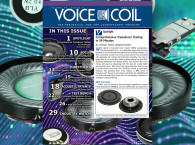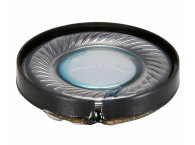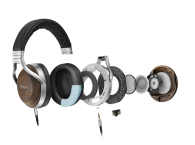
Thermoplastic films, from polyethylene terephthalate (PET) to PEEK, can be formed when the temperature of the plastic reaches above its glass transition temperature (Tg), changing from a glassy to a rubbery state—becoming pliable and moldable. After forming to the net shape, the polymer film becomes glassy again upon cooling below Tg. The diaphragm material and shape are the most significant contributors to speaker sound quality.
The cost for extruded polymer films start at less than $4/lb. for PET (bottle plastic), which dominates most earphone and headphone diaphragm applications. This is the lower end of plastics and while it works, it is no match for better products. As PET (polyesters) requires higher weight than PEEK to achieve shape integrity, PET diaphragms have a lot of unnecessary additives.
Types of Polymer Films
There are a half-dozen plastics that can be used as polymer films for diaphragms used in earphones, headphones, soundbars, smart speakers, laptops/tablets, and esoteric components such as ribbon planar drivers and air motion transformers (AMT). As mentioned, the most common is PET. First synthesized in the 1940s, PET was invented independently by both DuPont (Mylar) and ICI Films (Melinex). Because it is a cheap and a workable material, it has omnipotence in audio. The problem is that as with all thermoplastic resins, it softens when it gets hot. And, PET loses its mechanical integrity or Tg (glass transition) early on at about 78°C (172°F). The melting point Tm is 250°C (482°F) and while it is appealing to diaphragm forming factories to have such a low Tg and high melting point, this wide tolerance enables fast sloppy forming. Because of all of this, PET should be limited to entry-level products.
Yet even in products with modest audio expectations, if exposed to high temperatures, a product’s diaphragm is going to melt. In this article, we will discuss the importance of precision extrusion processing for resins in the production of films. The main message is that as with all cheap materials, it is handled as such. PET is a commodity material and high-speed processes are used with resulting film thickness variations typically exceeding 10%. The resulting diaphragms formed from variable thickness films not only vary in weight and — a far more serious result—the formed-edge compliance is not uniform.
Dr. Wolfgang Klippel’s team has published a number of Audio Engineering Society (AES) papers about their work on edge compliance and have found that surround edge variation is the dominant contributor to single-point suspension diaphragm rocking. If your company has the budget and wants a high-end product, you probably wouldn’t use PET. Even 30 years ago, there were upgrade options such as PEI (polyetherimide). Originally developed by General Electric (GE) and branded Ultem, the entire GE plastics group was acquired in 2007 by Saudi Basic Industries Corp. (Sabic).
Twenty years ago, PEI began to lose its speaker industry market share to DuPont’s improved polyester film called polyethylene naphthalate (PEN). Through acquisition of polyester specialist ICI Films in the UK and its Kaladex PEN film, followed by a joint venture with Teijin, Dupont Teijin PEN Teonex film entered the market and gained acceptance. Aside from PEN being a higher performance polyester compared to PET, pricing is competitive to PEI, and Teijin’s extrusion process was an improvement over PEI (Ultem).
Even PEI’s 1 mil (25μm) film was not tight enough for high-yield thermoforming, while Teonex offered consistent film extrusion. A couple of the leading pro sound speaker manufacturers developed popular and respected single- and dual-diaphragm ring radiator drivers using PEN films. But there is often a side effect with PEN, its forming temperature is quite close to its Tm (melt point), and challenged the capabilities of thermoplastic film forming industries.
When the polyester resins group of industry giant ICI was acquired by Dupont, the original ICI management and engineering team knew there was a proprietary and superior film technology completing development in their lab. There was a management buyout and Victrex emerged in 1993 focusing on the polyarlyether ketone (PAEK) polymer family, most notably PEEK (polyetherether ketone)-based products, which includes a PEEK film product line, marketed as APTIV branded films, that were launched in 2007.
Relative to PEI and PEN, the PEEK-based APTIV film is pricier, but the combination of high-temperature performance, outstanding fatigue resistance, lightweight, mechanical strength, durability, chemical resistance, wear, and abrasion resistance, good flammability rating without the use of flame retardants, and low moisture absorption all combined with ease of processing made PEEK film a no-brainer for audio engineers to use in their next-generation products. Beyond the resin material characteristics, Victrex developed PEEK films for the audio market by investing in its own next-generation film extrusion plant with high consistency down to films of 3μm thickness (25μm = 1 mil inch).

Early PEEK Applications
Early applications that were attracted to PEEK were ribbon planar transducer, Truextent’s beryllium compression driver edge suspensions and high-end tweeters. Cabasse, a French audiophile speaker manufacturer worked with Victrex for a mineral-filled PEEK for use in the tweeter diaphragm of its flagship La Sphere $275,000 speaker system (that is the price for a pair). The dissimilar homogenous materials of the mineral-filled PEEK diaphragm provided both high damping but also a better acoustic signature match to the woofer.
The extremely thin gauges of Victrex APTIV DBX PEEK film series enabled use of multiple thicknesses with tailored damping layers to tune the speaker characteristics and tame diaphragm resonances.
Headphone diaphragms typically have a very shallow cross-section and in many cases a bit more depth would result in vastly improved performance. By far, most headphone drivers are one-piece diaphragms of PET polyester, about 25μm (1/thousandth inch) thick. The top of the line in film diaphragms is two layers of very thin PEEK film laminated to a damping layer. On the high-end headphone diaphragm market the flagships of Sennheiser (HD-800 and HD-820), Beyer (T1), and AKG (K701 and K702 Variomotion) all have laminated PEEK diaphragms. AKG’s dual-layer Varimotion diaphragms are also used in its studio dynamic microphones.
While PEEK has been used in the high-end markets for decades now, it has also become product of choice in mass-market applications used in more than 4 billion smartphones in the compliance and integral element of the diaphragm because of its essentially unlimited fatigue life and consistent extrusion thickness avoids rocking modes at elevated excursions.
Surprisingly, most of these microspeakers use not just PEEK but laminated PEEK, to dampen edge compliance resonance. With acceptance in the largest microspeaker market and the high-end headphone applications, other markets that should consider using PEEK include laptops/tablets, car audio, TVs/soundbars, smart speakers, headphones, and true wireless earbuds.

Future Uses
A number of soundbar brands and their OEM vendors are in the design stages of exploring thicker PEEK diaphragms (10 mil and thicker) for compact full-range drivers that avoid the performance compromises of crossovers and tweeters. The formability of film diaphragms with effective decoupling and controlled effective radiating area vs. frequency enables smooth power response as well as linear and extended frequency response. Damping can be dialed in through mineral-filled content (Mineral fill – APTIV 1103) and/or PEEK laminates with constrained layer thermoplastic elastomer (TPE) or acrylic.
Precision Extrusion Uniformity
We have discussed earphone and headphone diaphragms, which are typically under 1 mil inch (25μm) gauge, and we now explore some applications that require thicker films. Compression drivers with 1.75” diameter diaphragms and up are more likely to be 2 mil and over, while there are 3.5” diameter auto-sound speakers of 10 mil. Conversely, on the thinner side, earphones are in the range of 12μm or less.
These finer gauges require precision extrusion processing, slower processing speeds, and skill. To be blunt, the film extruders in the US do not want to do business with the speaker industry and the feeling is mutual. One issue is that the toll extruders (processors for a fee) that take on all films are paid for tonnage, not quality—and are therefore not experts in the field.
The characteristics and tight extrusion process for higher performance materials is not just about superior consistency. Other performance goals are conferred by the symbiotic relationship of more uniform thinner gauge films of higher mechanical performance resulting in higher sensitivity, higher acoustic output with lower distortion, and less rocking. While typical cone speakers count on their two-point spider suspension to maintain coil centering and control rocking, in earphones, headphones, tweeters, and compression drivers, it is edge compliance that keeps things under control. Extruders processing premium engineering plastics use higher-grade machinery and far slower speeds.
Each resin type varies in brittleness and ductility, and many extrusion settings are best left optimized. The ultimate quality films are extruded in-house by the resin formulators (e.g., the in-house extrusion processing at Teijin in Japan for its Teonex or Victrex in the UK with APTIV). When you pack your own parachute, you take care. Thinner films of higher-grade resins are expensive — and cost per pound goes up drastically even through the lower material (resin) costs per part as the extrusion process is slower.

In Conclusion
While the cost of the PEEK diaphragm is slightly higher, there is no other component upgrade that can provide more sensitivity, extended response and cleaner sound for pocket change. It is common to find TWS 6mm earphone diaphragms with 9μm PET diaphragms and while sensitivity is high, so is distortion, and sound quality gets nasty at elevated levels while the PEEK diaphragm sounds and measures far better.
With a thickness tolerance of ±5%, Victrex’s APTIV DBX film has enabled more uniform thickness, resulting in greater part-to-part consistency, lower F0 and total harmonic distortion (THD) variability. Reducing the variance in film thickness increases diaphragm forming yield, lowers overall manufacturing costs by scrap, and is performed to meet production ramps.
Another not so obvious benefit of thinner precision film surrounds is the higher compliance and so the back air chamber volume can be shrunk, there because this air suspension contributes most of the diaphragm’s spring restoring force rather than the surround—enabling tighter production tolerances. Alternatively, liquid silicon rubber (LSR) has been intermittently used for the higher compliance but the LSR process seems to be out of the comfort zone of most of the manufacturers, and requires high tooling costs.
The diaphragm will always be the shortest path to clean sound, wider response, higher sensitivity, and tighter production tolerances. For the speaker market extremes, laminated PEEK dominates the dynamic headphone market, and also the microspeaker industry. With a number of soundbar engineering teams developing crossover-less solutions, the middle of the market is next. VC







